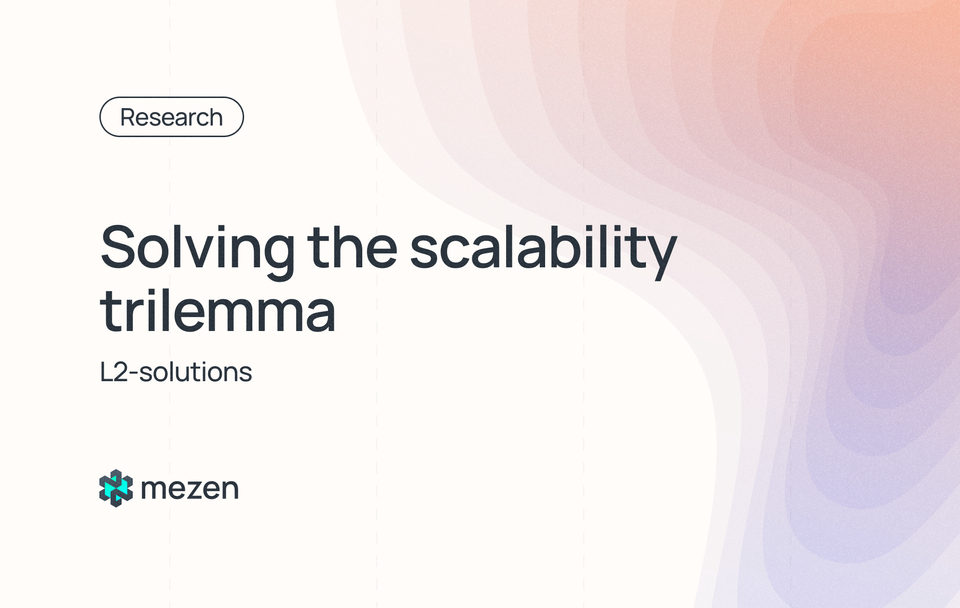Solving the scalability trilemma: L2-solutions

Since the introduction of Bitcoin in 2009, blockchain technology has continued its organic development and has undergone many changes. With more and more innovations, blockchains have reached a new level of adoption, allowing the underlying technology to be used in a variety of ways in different cases. One of the breakthrough innovations has been Layer 2 networks. Arbitrum, for example, is passing 1.5M transactions per day at launch and has been used by over 23.0M unique addresses.
So what are Layer 2 networks, and how are they fundamentally different from Layer 1 networks?
What is L2-blockchain?
A Layer 2 network is an off-chain network, system, or technology that is built on top of a blockchain, also known as a Layer 1 network, to expand the capabilities of the underlying base layer network. The purpose of a Layer 2 network is to introduce enhancements, such as higher transaction throughputs, to any blockchain it supports.
To qualify as a Layer 2, a network, system, or technology must meet a fundamental requirement, which is to inherit the security of the blockchain it is built upon. Transaction data must be verified and confirmed by the underlying blockchain network instead of a separate set of nodes.
Need for L2 blockchain solutions
Blockchains have an inherent problem known as the "scalability trilemma". Coined by Ethereum Co-founder Vitalik Buterin, the blockchain scalability trilemma posits that blockchains are incapable of scaling effectively while keeping the underlying network both secure and decentralized. Instead, there must be tradeoffs between these three features—today’s blockchain networks can fulfill two out of the three conditions, but not all three simultaneously.

Figure 1. Blockchain trilemma. Source: Chainlink
When the early blockchains (such as Bitcoin and Ethereum) were designed as an alternative to the existing monetary system, developers prioritized the benefits of decentralization and network security. These blockchains were not designed for a large number of transactions and users and are characterized by low throughput: in Bitcoin, it is 4.3 transactions per second, and in Ethereum — about 14.4. At the same time, most modern blockchains are not characterized by high transaction speeds either: Algorand — 22.7 TPS, Avalanche — 8.7 TPS, Near — 130.0 TPS. For comparison, the Visa payment system processes more than 24 thousand transactions per second. An additional problem is the high level of transaction fees in the network.
L2 solutions provide a partial solution to the problem of low transaction bandwidth and high fees without affecting the code of the underlying blockchain. They inherit the security of the main blockchain and, by processing transactions of the parent chain, make the process more efficient.
Types of L2-solutions technology
Sidechains
Independent blockchains, called sidechains, have their own native tokens and consensus mechanisms. These sidechains are designed to assist in scaling the parent network. A two-way bridge connects them to the parent blockchain, allowing users to transfer assets between the two networks.
The two chains do not transfer assets to each other. Sidechains use a mechanism called a two-way peg, which involves locking up assets on the main chain through a smart contract and creating an identical set of tokens on the sidechain. The newly created assets are valued based on the assets on the original chain.
They tend to utilize their own validators and consensus mechanisms, which results in a distinct set of security assurances compared to those of the base layer chain.
Therefore, sidechains, such as Rootstock for Bitcoin smart contracts, or Gnosis for Ethereum, are not considered L2 solutions.
Rollups
Rollups can improve throughput and reduce costs by performing smart contract state changes off-chain and proving them on-chain. Scalability with rollups is achieved through the following three methods:
- Rollups perform off-chain execution of transactions, requiring that the underlying base blockchain only needs to execute small proofs to verify network activity and store raw transaction data.
- Rollups batch transaction data together when submitted to a blockchain so that the on-chain gas cost is distributed across a number of transactions.
- Rollups only require a minimum of one honest validator to prove the validity of transactions to the base layer blockchain, allowing for smaller validator sets and increased hardware requirements without significantly compromising security.
There are two categories of rollups: Optimistic rollups and zero-knowledge (zk) rollups.
- Optimistic Rollups. Transactions are processed in the L2 network and then grouped together into a condensed block before being validated and included in the Ethereum main network. Both Arbitrum and Optimism utilize Optimistic Rollups as their processing technology.
- ZK-Rollups. Transactions within the Layer 2 network are aggregated into packets and transmitted to the Ethereum network. However, these transactions are verified using special cryptographic proofs, called verifiers, to ensure their validity. Polygon is developed based on ZK-Rollups technology.
Future of L2 blockchains
The adoption of blockchain technology in the real world is increasing, and to further develop it, the focus is on scalability, fast transaction speeds, and low gas fees for both L1 and L2 blockchains. L2 blockchains are expected to offer even faster transaction times and bring down costs to a whole new level. The proliferation of L2 blockchains, coupled with these advantages, will undoubtedly lead to the development of new applications, particularly in the DeFi space.
Additionally, the building of more bridges between various L2 blockchain platforms will allow for higher blockchain interoperability, enabling users to enjoy the benefits of open avenues, such as the trading of digital assets.


Comments ()